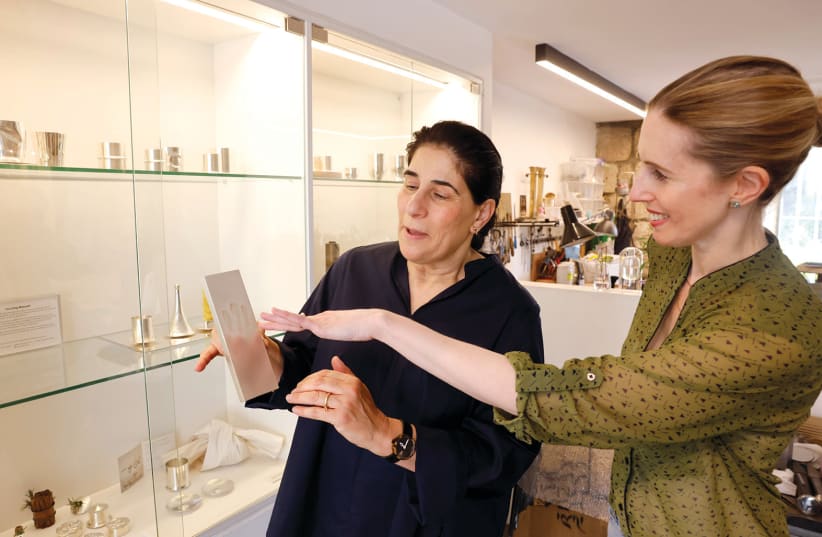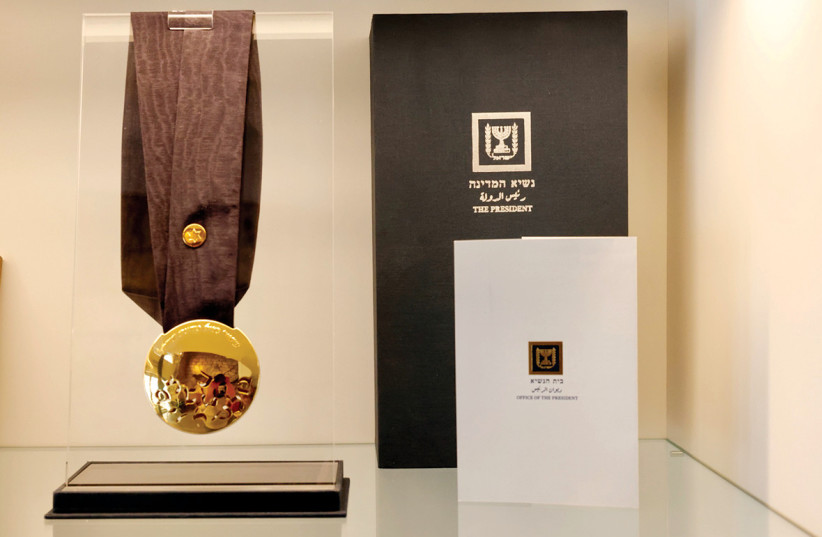
This is a bit of a different "At the Table" column.
Normally, I would zero in on a Jerusalemite of note, then make arrangements to meet up in the city to drink, nibble, and get to know each other in a light-hearted setting.
In this case, we met by chance at Birma Coffee, the charming roastery in a sunny alley off Emek Refaim Street. It was Friday, a relaxed day off, and I was there to sip on a matcha latte for a pre-Passover catch-up with my friend Roochie Fishel Sinai. As is typical in our homey Jerusalem village, Roochie – a talented mosaics artist – ran into a friend. This friend was renowned silversmith designer Sari Srulovitch, who I learned had secured Roochie her much-loved space in the Hutzot Hayotzer artists colony, and, it transpired, designed the Presidential Medal of Honor for Israel’s 75th anniversary.
Being that I believe there is no such thing as a coincidence, it quickly emerged that Sari would be an ideal companion for this column.
SO THERE I found myself, a short time later on a warm spring day, with Roochie in the ordered clutter of Sari’s studio.
Taking pride of place is Sari’s workbench, where she practices the traditional silversmith methods of raising, hammering, and chasing, alongside modern technology. Amid the works in progress is also the feel of a museum, as assorted Judaica made of metal shine from illuminated display cases lining the wall. Sari has participated in a number of exhibitions, including at the Israel Museum, where she contributed silver Torah shields and pointers for the “Pointing the Way: Women Design Ceremonial Objects” show.
Humble and approachable: Acclaimed artist Sari Srulovitch
Clad in an elegant, loose navy top and pants with green velvet shoes, Sari is clearly in her happy place, the “room of one’s own” where she creates, processes life’s challenges and victories, and expresses emotion via art. Her love for Israel, specifically its capital and its people, radiates from every work.
An open book, she is humble and easy to talk to, despite her many awards and accolades.
“My soul is in Jerusalem,” she says many times. Born in 1964, she was raised first near what is today the bustling Bar-Ilan junction, then small and dotted with gardens. Moving to Ma’alot Dafna, hers was the only religious family in the neighborhood, where they “all played together”; today the area is haredi, she says, smiling wryly.
Raised in a close-knit family, she was inspired by her mother’s embroidery. But art wasn’t always in the cards.
First considering social work, Sari served in the IDF as a kzinat nifgai’im, a point person for the wounded and their families, and for families that lost loved ones in the army. While she threw herself into service and is proud of what she accomplished at a young age with few resources, she realized that the sadness involved was taking its toll.
She pivoted, studying in the metalwork and jewelry department of Jerusalem’s Bezalel Academy of Art and Design, then spending two and a half years at London’s Royal College of Art – “my only years out of Israel.”
Combining her love of her country, of Jerusalem, and the wisdom from her army service, she took a cue from the Ba’al Shem Tov to see God inside everything. A career in Jewish ceremonial art seemed natural and was clearly the right choice. Her passion is clear: “For 30 years, every day I open the gate to Hutzot Hayotzer, I give thanks to Hashem.”
Her calling got her through the difficult days of the pandemic, the studio her daily destination. It also gave her an outlet for interpreting the horrors of Oct. 7. Her memorial objects are particularly stirring, with pieces pulled apart, then fitted together to repair the tears (k’riah) and fill the void (chalal).
“Since Oct. 7, I often get a lump in my throat when I discuss my work,” she tells me. “It’s so personal.”
WHILE I could write hundreds more words about what makes Sari Srulovitch tick, the best communication of her character and essence is through her art.
Materials incorporated with the silver include fabric and Jerusalem stone. Every angle is personal, every shape has meaning (stripes reference tallit and tefillin, for example). Taking us on a journey through the cycle of life, we view Israel and the Jewish people’s triumphs and tragedies through her compassionate, loving lens.
May we all come together to make the broken whole.■

